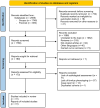A Systematic Review on the Genetic Contribution to Tinnitus
- PMID: 38334885
- PMCID: PMC10907330
- DOI: 10.1007/s10162-024-00925-6
A Systematic Review on the Genetic Contribution to Tinnitus
Abstract
Purpose: To assess the available evidence to support a genetic contribution and define the role of common and rare variants in tinnitus.
Methods: After a systematic search and quality assessment, 31 records including 383,063 patients were selected (14 epidemiological studies and 17 genetic association studies). General information on the sample size, age, sex, tinnitus prevalence, severe tinnitus distribution, and sensorineural hearing loss was retrieved. Studies that did not include data on hearing assessment were excluded. Relative frequencies were used for qualitative variables to compare different studies and to obtain average values. Genetic variants and genes were listed and clustered according to their potential role in tinnitus development.
Results: The average prevalence of tinnitus estimated from population-based studies was 26.3% for any tinnitus, and 20% of patients with tinnitus reported it as an annoying symptom. One study has reported population-specific differences in the prevalence of tinnitus, the white ancestry being the population with a higher prevalence. Genome-wide association studies have identified and replicated two common variants in the Chinese population (rs2846071; rs4149577) in the intron of TNFRSF1A, associated with noise-induced tinnitus. Moreover, gene burden analyses in sequencing data from Spanish and Swede patients with severe tinnitus have identified and replicated ANK2, AKAP9, and TSC2 genes.
Conclusions: The genetic contribution to tinnitus is starting to be revealed and it shows population-specific effects in European and Asian populations. The common allelic variants associated with tinnitus that showed replication are associated with noise-induced tinnitus. Although severe tinnitus has been associated with rare variants with large effect, their role on hearing or hyperacusis has not been established.
Keywords: GWAS; Genetics; Heritability; Prevalence; Rare variation; Tinnitus.
© 2024. The Author(s).
Figures


Similar articles
-
Burden of rare variants in synaptic genes in patients with severe tinnitus: An exome based extreme phenotype study.EBioMedicine. 2021 Apr;66:103309. doi: 10.1016/j.ebiom.2021.103309. Epub 2021 Apr 1. EBioMedicine. 2021. PMID: 33813136 Free PMC article.
-
Genome-wide association study identifies new loci associated with noise-induced tinnitus in Chinese populations.BMC Genom Data. 2021 Sep 6;22(1):31. doi: 10.1186/s12863-021-00987-y. BMC Genom Data. 2021. PMID: 34482816 Free PMC article.
-
Self-reported hearing problems among older adults: prevalence and comparison to measured hearing impairment.J Am Acad Audiol. 2011 Sep;22(8):550-9. doi: 10.3766/jaaa.22.8.7. J Am Acad Audiol. 2011. PMID: 22031679
-
Heritability and Genetics Contribution to Tinnitus.Otolaryngol Clin North Am. 2020 Aug;53(4):501-513. doi: 10.1016/j.otc.2020.03.003. Epub 2020 Apr 23. Otolaryngol Clin North Am. 2020. PMID: 32334875 Review.
-
Hearing Loss, Tinnitus, Hyperacusis, and Diplacusis in Professional Musicians: A Systematic Review.Int J Environ Res Public Health. 2018 Sep 26;15(10):2120. doi: 10.3390/ijerph15102120. Int J Environ Res Public Health. 2018. PMID: 30261653 Free PMC article.
Cited by
-
Mourning for Silence: Bereavement and Tinnitus-A Perspective.J Clin Med. 2025 Mar 25;14(7):2218. doi: 10.3390/jcm14072218. J Clin Med. 2025. PMID: 40217670 Free PMC article.
-
Tinnitus risk factors and its evolution over time.Nat Commun. 2025 May 7;16(1):4244. doi: 10.1038/s41467-025-59445-3. Nat Commun. 2025. PMID: 40335454 Free PMC article.
References
-
- Cederroth CR, PirouziFard M, Trpchevska N, Idrizbegovic E, Canlon B, Sundquist J, Sundquist K, Zöller B. Association of genetic vs environmental factors in Swedish adoptees with clinically significant tinnitus. JAMA Otolaryngol Head Neck Surg. 2019;145(3):222–229. doi: 10.1001/jamaoto.2018.3852. - DOI - PMC - PubMed
Publication types
MeSH terms
Grants and funding
LinkOut - more resources
Full Text Sources
Medical

